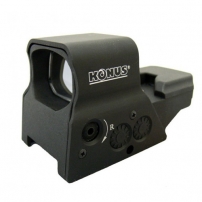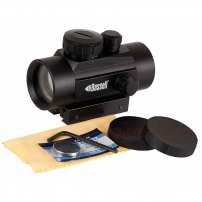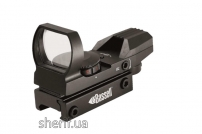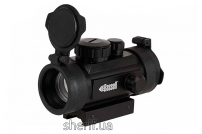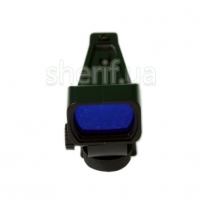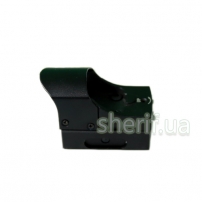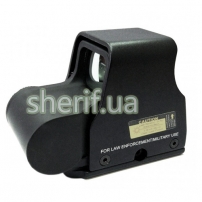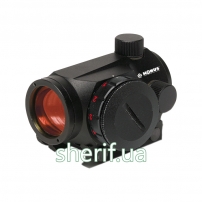√ Reflex sights



| Продолжение каталога см. на след.страницах |
1. Development
2. Operating principle
3. Varieties
4. Holographic sights
5. Advantages and disadvantages
6. How to choose
7. Where to buy a red dot sight
1. Development of collimator sights
The predecessor of the collimator sighting mechanism can be safely called the “optical front sight”, which had approximately the following device: a collecting lens cut along the optical axis and a front sight located at the focus. It was invented at the beginning of the last century. Due to the imperfection of this system, it did not receive wide distribution, but it was already able to realize the purpose of modern sights of this type - to combine the brand and focus of the optical element, it made it possible to view both the mark and the target itself with the same sharpness.
Initially, collimators were adopted by the aviation of the Second World War for artillery and bombing guns. The tandem of these devices and small arms became popular only in the early 80s.
2. The principle of operation of the collimator sight
Works on the basis of light collimation (creation of a parallel beam). This is achieved in the simplest case with a focusing lens and a concave mirror. Why are such devices needed? The first reason is the optics of the human eye, which cannot simultaneously focus on the front sight, rear sight and target. Accordingly, when aiming, you have to focus on them one by one.
The second - in the optics of the sight itself, which obliges to be located on the aiming axis both the axis of the weapon barrel (the axis of the optical sight, the rear sight system, etc.), and the observer's pupil (to put it in special terminology, it does not allow parallax or "does not extinguish parallax" ). A collimator sight allows you to solve these problems, as if placing an aiming mark directly on the target, regardless of its distance, and allowing the shooter to aim, looking at the sight at an angle.
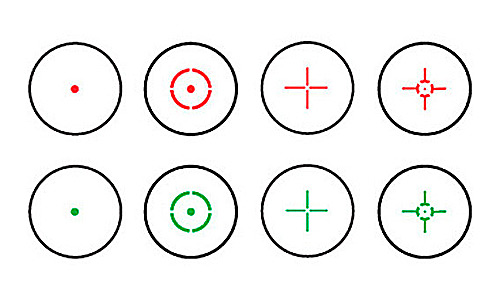
This label is also called a brand. The shape of the brand varies depending on the manufacturer, and the purpose of the sight. The main ones are dot, circle, cross and their variations. In a number of devices, you can also change the brightness of the brand. In fact, the aiming mark is created by projecting onto the lens from the LED, which, in turn, is powered by hermetically built-in batteries.
Collimator sight , like an optical one, can have a magnification, but since most of the weapons on which it is used require a high aiming speed, which is usually low so as not to disorient the shooter too much when moving to the next target instantly or moving quickly relative to it. But the magnification can be increased by installing additional optics in front of the collimator with a collimator, for example, some manufacturers produce optical sights compatible with it.
3. Varieties of collimator sights
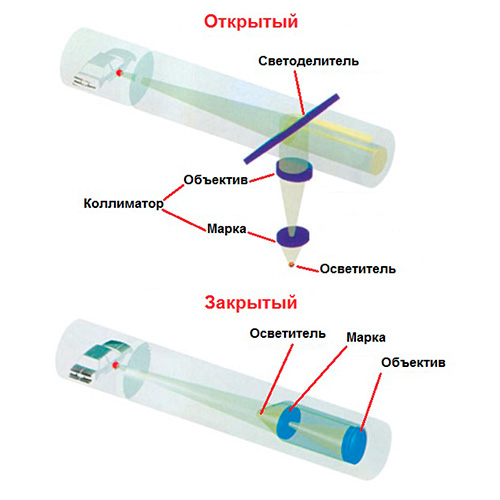 Usually there are open and closed types of collimators. Both of these types are called through. To. the light passes through and you can aim with one or two eyes.
Usually there are open and closed types of collimators. Both of these types are called through. To. the light passes through and you can aim with one or two eyes.
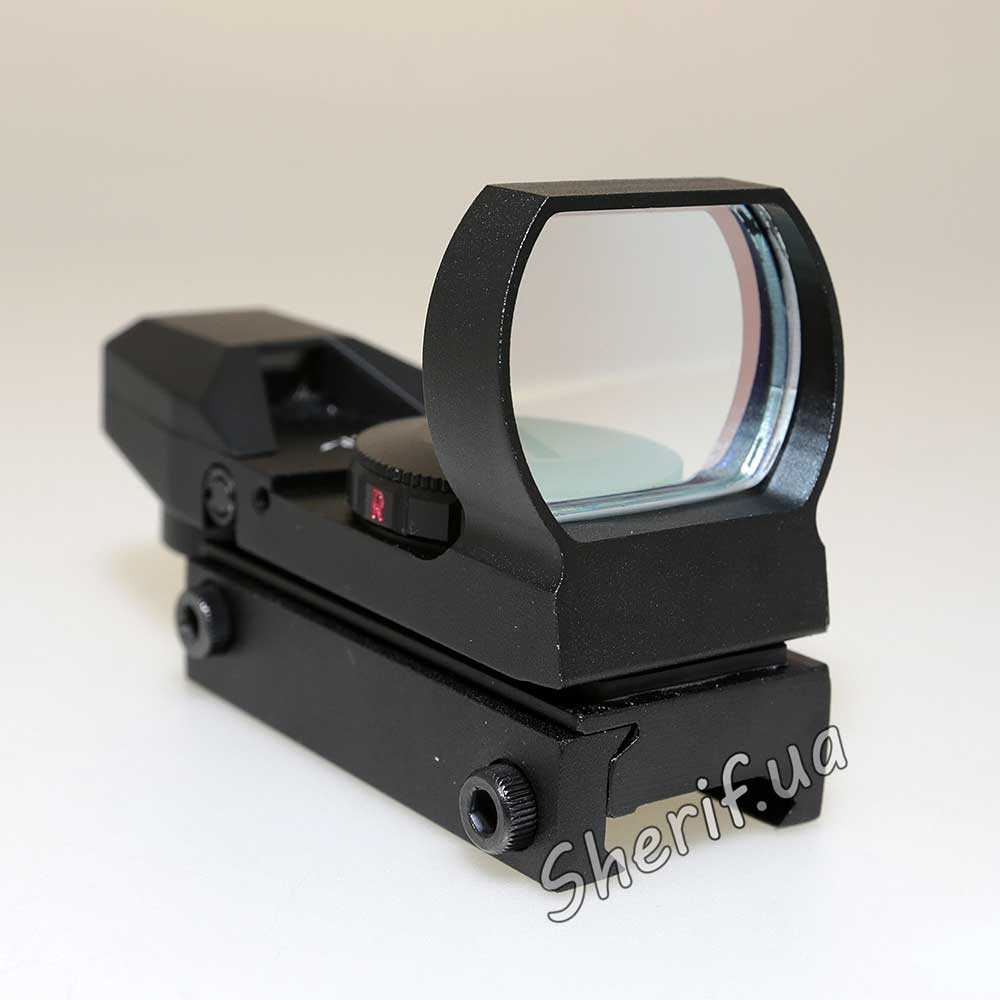 Open - looks like a lens in a thin frame. It provides a good overview, but it is completely unprotected both from mechanical damage and from the vagaries of the weather. An example of an open collimator sight is this one .
Open - looks like a lens in a thin frame. It provides a good overview, but it is completely unprotected both from mechanical damage and from the vagaries of the weather. An example of an open collimator sight is this one .
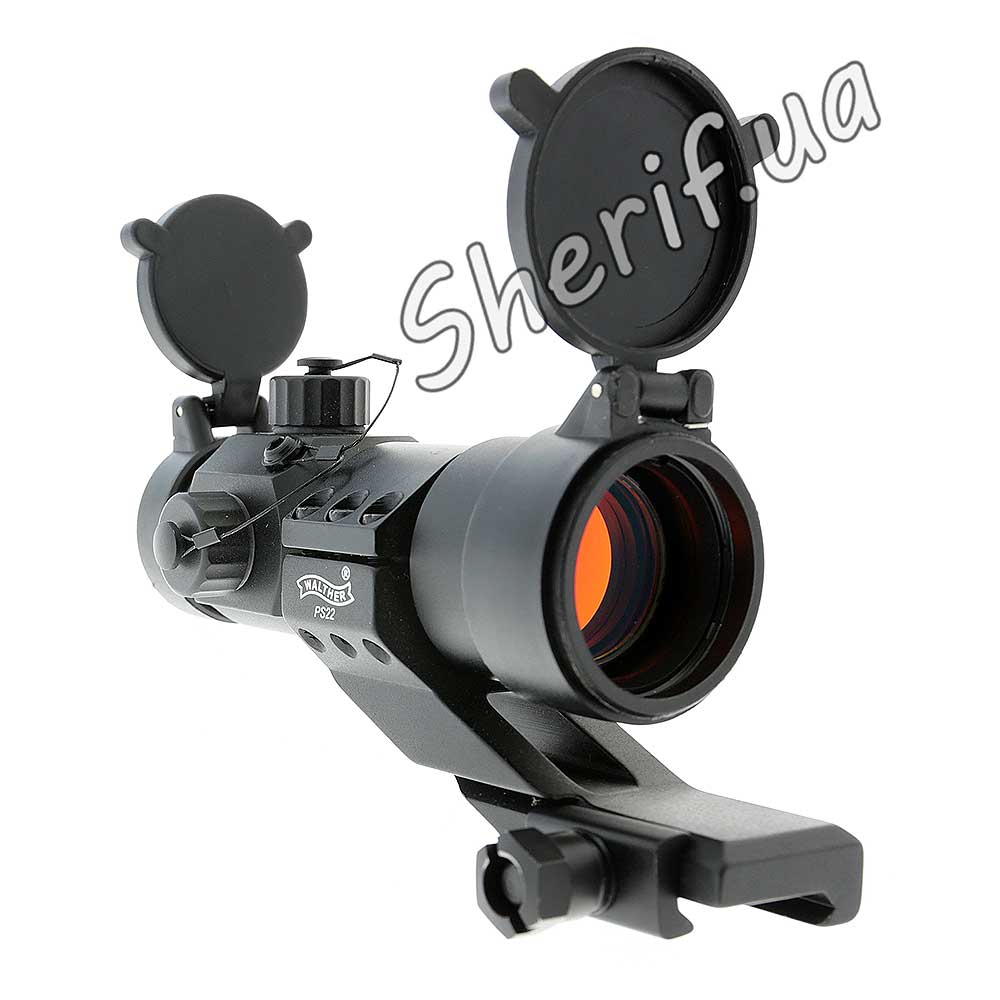
Closed - looks like optical, but smaller. The view is narrower than that of the open view, but at the same time it is more reliable in operation.
For example, the collimator closed sight Walther PS 22 (2.1020) .
Relative disadvantages include the need for special care, careful treatment and periodic replacement of batteries.
Nevertheless, it is they who are in service, probably, with all the armies of the world.
Help with the choice and answer any questions can always be our hospitable managers with extensive experience and a keen sense of smell.
In addition, other classifications can be used, for example, if it is possible to observe the target, stereoscopic and conventional ones are distinguished, respectively, with and without a sighting channel.
Stereoscopic sight , it is also called "blind", opaque. You need to aim with it in two open eyes, while the right one sees only the mark, and the left one sees the target itself. The brain is able to “combine” two images received from each eye into one and see such an image, as in a transparent collimator sight.
You can consider such devices from the constructive side (if possible, attaching to a weapon). They can be universal and suitable for everything, specialized - with mounts for certain models and already built into the weapon itself.
4. Holographic sights
Actually, they are a technological continuation of the collimators - all the same pointing speed and the ability to aim, deviating the head from the aiming axis, which is useful when shooting from cover, moving with a tactical step, and so on. But with one very important bonus - maintaining the combat capability of the sight in case of violation of the integrity of the lens, its contamination or partial overlap. This is achieved by the fact that such sights are devoid of an optical collimator system and project the brand not on glass, but are formed by laser illumination in the internal space. They can display not only a dot, but also round shapes, crossing lines, or the continuation of the barrel towards the target and have several degrees of brightness, including night vision mode, when the mark is not visible to the naked eye at all. A holographic sight can be a great addition to a night vision device.
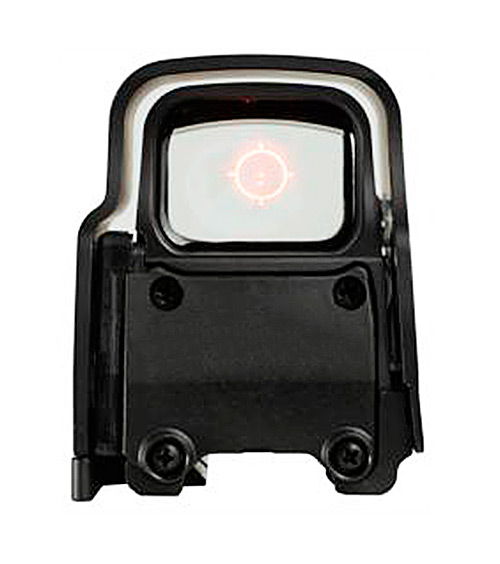
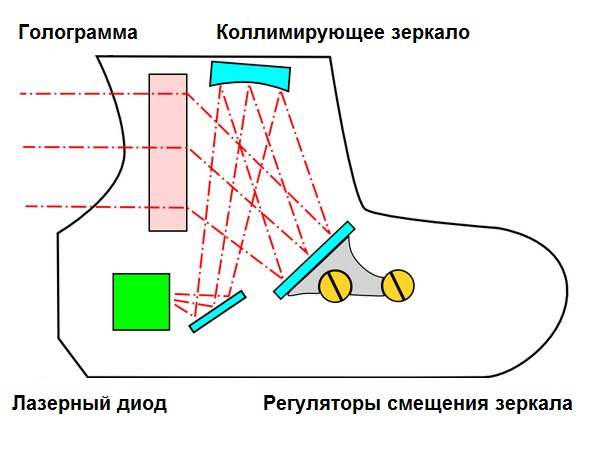
5. Advantages and disadvantages of collimator sights
First of all, it is necessary to note the simplicity of aiming - one has only to point the mark at the target, even an absolutely inexperienced shooter will cope with this task.
The effectiveness of shooting depends a lot on the sight, and the collimators here occupy confident positions, because To. aiming speed is 3-8 times faster than standard and optical ones.
Regarding laser designators, collimators also have their own advantages - they do not unmask the shooter.
Another plus is that the twilight time has practically no effect on the quality of shooting, as well as visual defects. Some modifications are even quite capable of competing with night sights, and if necessary, collimator sights can be combined with night vision devices and laser sights .
They will have a good effect on balance and other weapon tuning subtleties. Neither the brand nor the barrel of the weapon will cover the target, as is often the case with conventional sights.
With a collimator mechanism, it is easy to shoot a weapon with bullets, since they have a wide range of adjustment, and in general, shooting bullets is much more accurate and more convenient with such sights.
Experienced hunters recommend them for hunting birds, and they are also considered ideal for pneumatics , etc. "small things" - small-caliber weapons. Interestingly, the collimators are good for sports competitions and, if there is a mark for the angle of incidence of arrows, they are compatible with crossbows .
Among the shortcomings, in addition to the already discussed care, one can note the limited firing at long distances, since the device itself mainly provides for a multiplicity = 1.
6. How to choose a collimator sight?
As with any product, before buying, you need to determine the conditions for its use. For example, if you intend to use it in low temperatures or the possibility of splashing, as well as the likelihood of light shaking, then you need to buy a closed-type scope .
For firearms and pneumatic weapons, open sights are well suited, they are able to withstand the recoil of even large calibers.
A lot of attention should be paid to the choice of aiming mark. First, it's her color. The usual red stamp is more common, but not always distinguishable, depending on the background color. The green mark is more modern and stands out better, there are also models with a variable color of the aiming dot.
Secondly, it is good if the brightness of this very point is regulated in the model, i.e. To. in low light or in cloudy weather, it should not be bright, so as not to create discomfort to the eyes and not illuminate the target, and in sunny weather, it should, accordingly, be maximum.
Also pay attention to the type of attachment, ie. To. most of the described sights are available with an integrated bracket. Let's briefly talk about the two most common - Picatinni rail with a step of 0.394 and Weaver - 0.180. Weaver rails are compatible with Picatinny rails, but it doesn't always work the other way around - Picatinny rails are more capricious.
Naturally, to no lesser extent, the choice of a collimator sight will depend on your subjective preferences and the price of the device. The ideal option is, of course, holographic.
7. Where to buy a collimator sight inexpensively?
The staff of the Sheriff store sincerely wishes you to buy exactly the sight that you dream of, so that it will serve a good and long service and be useful in your favorite hobby!
You can get acquainted with the assortment, with the price policy for products and buy the one you like at the address: st. Artem, 9, in the city of Dnepropetrovsk . Or order on the site sherif.ua with delivery to the city of your residence or location. Whether it is Zaporozhye, Bila Tserkva, Kirovograd, Uzhgorod, Poltava or Odessa.
The prices in the Sheriff military equipment store will delight you with their loyalty.
(068) 300-5000 (063) 798-9999 (095) 233-0000 (068) 300-5000
(068) 300-5000



